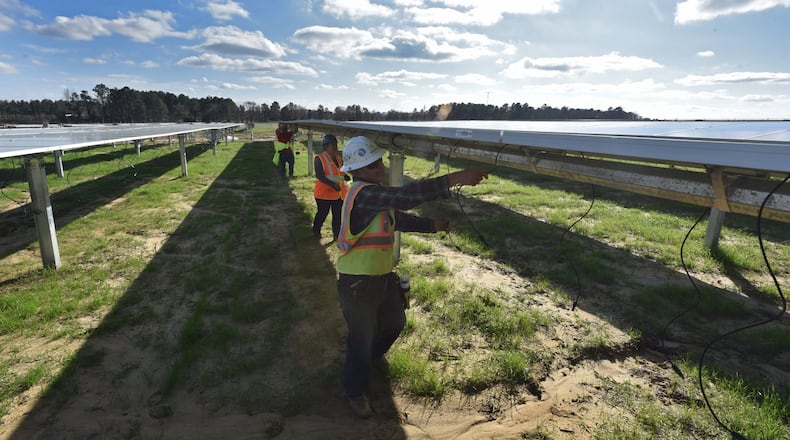A hundred miles southeast of Atlanta, some 2,000 acres of sawed-over timberland is about to be planted with what may be Georgia’s hottest crop: row upon row of solar energy panels.
Juice from the nearly 600,000 panels in Twiggs County will flow in every direction, including north to energize metro Atlanta cellphone chargers, refrigerators and anything else that wants for electricity.
A decade ago, coal was king in Georgia. Solar energy was written off as virtually meaningless in the eyes of Georgia Power, the state’s dominant electric company, and many other utilities. But a power shift is undeniably underway, and with it comes upsides for metro Atlanta consumers: A cheap source of energy and none of the carbon footprint that has been blamed for worsening climate change.
Georgia Power’s newly updated 20-year energy plan calls for closing five coal-burning units. Additionally, two of the four at its largest coal facility, Plant Bowen in Cartersville, could be shuttered in the next few years.
The utility would rely most heavily on inexpensive natural gas-burning plants. But it also plans to boost renewable energy generation by almost a third, likely mainly through solar rather than wind or biomass energy.
Right now, the sun supplies just a fraction of Georgia Power’s energy: less than 3 percent of what it sold in 2018. The company declined to publicly disclose what it projects that number will be in the future. Yet its solar holdings have been growing for years. By one measure, it could amount to nearly a fifth of Georgia Power’s peak summertime generating capacity by 2024, according to public disclosures filed with the state.
That would almost equal the capacity expected to come from all of Georgia Power's remaining coal plants. It also would exceed the company' nuclear power capacity, even after completion of the Plant Vogtle expansion, which is years behind schedule and billions of dollars over budget.
The sun’s rise might not stop there.
Advocates predict that declining prices for solar equipment will add pressure on Georgia Power to rely on solar energy even more than what the company proposes. And they have a potential ally in state utility regulators, all Republicans, who began pushing Georgia Power toward sunlight several years ago.
Why? Solar panel efficiency soared and prices plummeted even faster than many expected. Low interest rates enticed project backers. Rural land was cheap and often flat. Sunshine was plentiful. Other locales had found solar could work.
“I call it the perfect storm for solar in Georgia,” said longtime Georgia Public Service Commissioner Lauren “Bubba” McDonald.
When Georgia Power didn’t propose a single new watt of solar power, McDonald pressed for a solar infusion. He won just enough support from fellow elected members of the PSC, which regulates the utility. They didn’t, though, use the word mandate, a politically dangerous term in the state’s conservative circles.
Concerns over humidity, low clouds dissipate
Solar continues to grow nationally, even as President Donald Trump, whom McDonald supports, has pushed to revive the U.S. coal industry. The president's administration also has worked to undo some carbon-limiting regulations that further threatened coal.
Still, the number of U.S. coal plants continues to shrink. Georgia Power says its coal-fired generating capacity is nearly half what it was in 2005.
And there’s no turning back for solar, said James Marlow, who previously led Atlanta-based engineering and installation company Radiance Solar. “The only thing I’m absolutely certain of is there is going to be a lot more solar, and it is driven by economics.”
A mix of market and government moves are providing some of the fuel around the nation, even as temporary tariffs on imported Chinese solar panels appeared to slow growth. Florida Power & Light recently announced plans to install in excess of 30 million solar panels by 2030. And California is requiring that all new homes include solar power, starting next year.
For metro Atlanta consumers, the increase in solar could help hold down monthly power bills, though perhaps not enough to prevent projected increases tied to the Vogtle nuclear expansion. Solar has no fuel costs. And it is free of some toxic leftovers and air pollution, including carbon emissions.
There are concerns. Solar energy is intermittent, affected by everything from nighttime to the sun sitting lower on the horizon during the winter.
For years, power companies viewed solar as inefficient, expensive, sporadic and a threat to their business model in both the short and long term.
Some state regulators concurred. “Georgia’s humidity and low cloud cover make it a very unlikely and high-cost source for production in Georgia,” then Georgia Public Service Commissioner Stan Wise wrote in 2009.
But the weather proved not to be such a barrier.
Johan Vanhee of solar developer Origis Energy, part of a cottage industry that has grown nationally, recalled visiting Georgia seven years ago despite the cautions he heard.
“People told me not to look at the Southeast because the Southeast is not looking for renewable energy,” Vanhee said.
Now, he is developing his fourth and fifth solar installations that will supply energy to Georgia Power. That includes the Twiggs County project, expected to be the largest in the state. It is slated to go on line late this year and generate enough peak electricity to power 35,000 homes.
A variety of other big and small players are aiming at the sun. Facebook's nearly 1 million-square-foot data center planned east of Atlanta in Newton County will get electricity from proposed solar outposts. (Cox Enterprises, which owns The Atlanta Journal-Constitution, also has invested in solar projects.) In South Georgia's Terrell County, farmer Ronnie Lee spent $1 million to put panels on his drying shed and nearby land. Now, a solar company is installing panels on 15 acres where he grew cotton just last year.
Meanwhile, Georgia Power has closed a number of aging, expensive coal units and significantly increased its reliance on less-polluting and more affordable natural gas-burning plants.
Georgia still moving more slowly than some other states
In its latest energy plan, which it is required to update and get PSC approval of every three years, the company is calling for nearly twice as much new renewable energy as what it had proposed last time. But the proposed 1 gigawatt of additional renewables is still less than what the company ultimately agreed to in 2016. Georgia Power also wants to create energy storage that could be paired, in part, with solar energy generation.
It is pursuing a “steady and measured approach to adding renewables,” a company spokesman wrote in an email to the AJC. That “allows us to capture the current market benefits and mitigate the risk of upward pressure on rates as costs decline and efficiencies improve.”
Environmental groups were torn between offering some praise and criticizing the company. Adding solar and reducing coal are good moves, they said. But Georgia Power has failed to improve weak energy efficiency programs and isn’t moving aggressively enough on either solar or coal, some said.
“They should be much more bullish on solar,” said Stephen Smith, the executive director of Southern Alliance for Clean Energy.
Pushed by the PSC, Georgia was once one of the fastest growing states for solar in the nation. But the state’s momentum has eased compared with others, he said, speculating that Georgia Power has been distracted by troubles with its nuclear expansion project.
The state is now ranked 11th nationally on installed solar energy capacity, according to the Solar Energy Industries Association. It’s behind not only sunny places such as Florida, Texas and California, but also North Carolina, New Jersey and New York.
While Georgia officials have sometimes encouraged solar, they haven’t enacted the robust incentives of some other states.
Most of Georgia’s solar action has been centered around sprawling fields of solar panels often under contract to utilities. Less is being done with home rooftop systems that give consumers more control over their bills and less reliance on utilities.
Federal tax credits exist, but will expire soon for residential customers and decrease sharply for businesses. Some Georgia utilities charge steep extra monthly fees for solar-powered homes connected to their system, while offering only small bill credits for extra power they produce and feed to the grid, said Russell Seifert, who chairs the Georgia Solar Energy Association and founded Kennesaw-based solar installer Creative Solar USA.
So while residents in Florida, North Carolina, South Carolina, Louisiana and Virginia added thousands of new residential solar systems over the last two years, Georgians added just 57, according to SEIA.
Said Seifert, “We are talking the rabbit and the turtle.”
About the Author
The Latest
Featured




